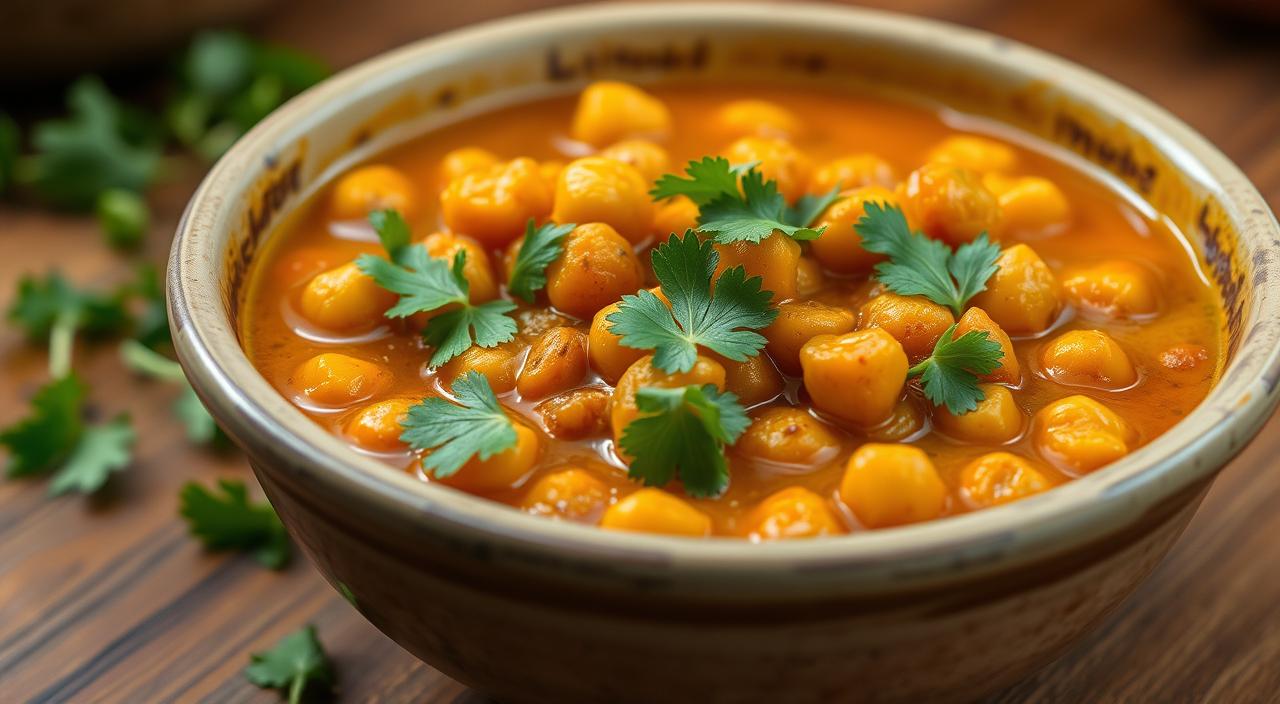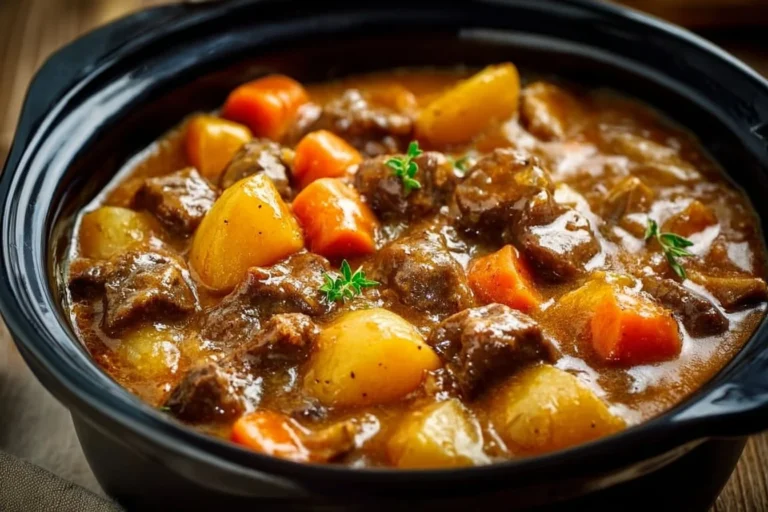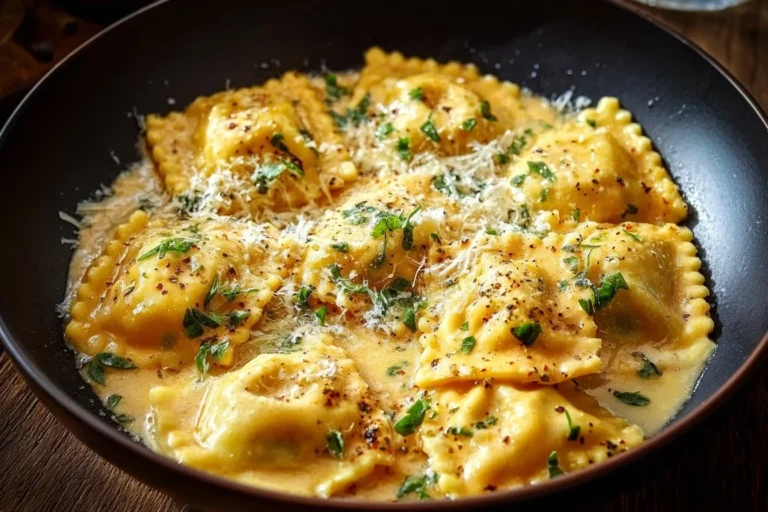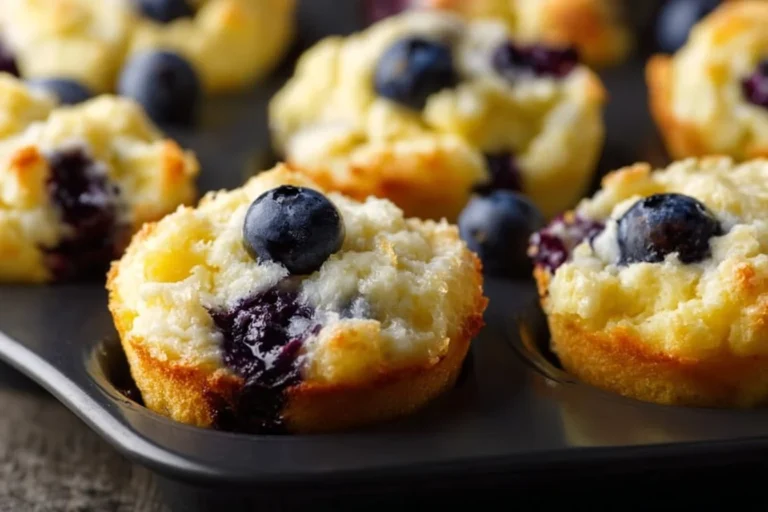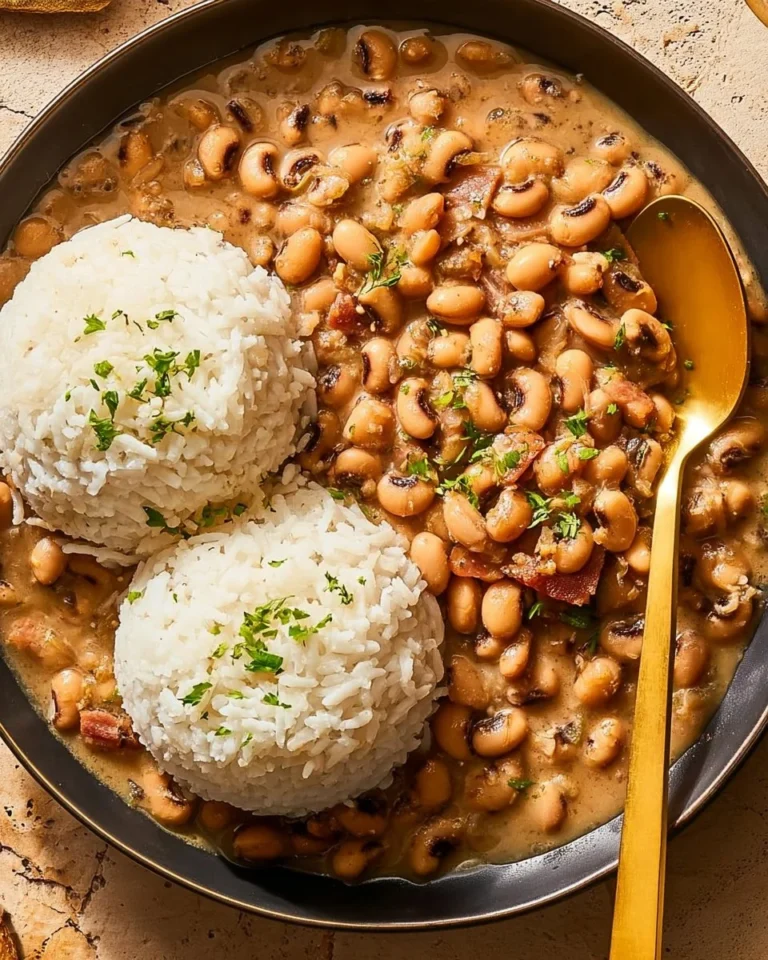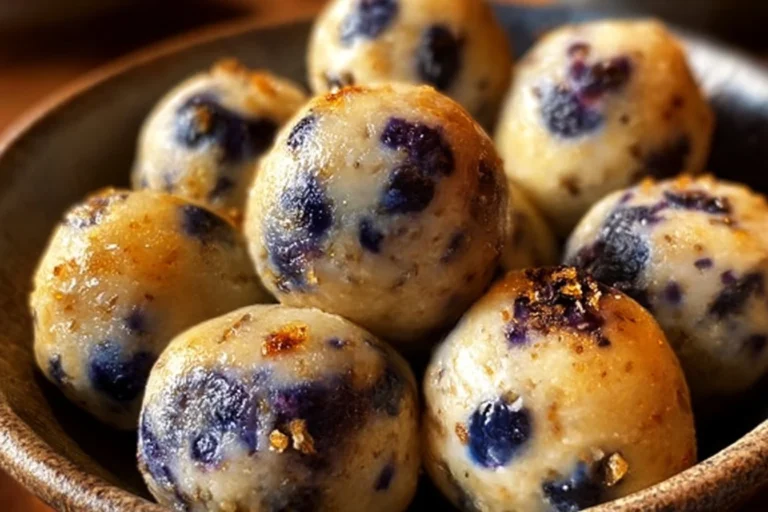Chickpea Curry: A Tasty Vegetarian Recipe
Looking for a meal that’s both filling and plant-based? Our vegetarian chickpea curry could be your new go-to! It combines the creamy texture of chickpeas with the rich flavors of coconut and spices.
This recipe is easy for anyone to make. It’s bold enough to thrill your taste buds but simple for busy weeknights.
What makes this dish stand out is our special blend of spices. Our homemade curry lets you adjust the heat to your liking. This way, you get the full flavor of Indian cuisine.
This meal is not only delicious but also packed with protein. It’s also easy on your wallet, using common ingredients that turn into a feast with a few steps.
Whether you’re a vegetarian or just trying meat-free options, this Easy Chickpea Curry is a must-try. Let’s make this tasty dish together!
Key Takeaways
- Perfect balance of authentic flavor and beginner-friendly preparation
- Rich in plant-based protein and fiber from chickpeas
- Customizable spice levels to suit your personal preference
- Budget-friendly ingredients that create a restaurant-quality meal
- Ready in under 30 minutes for quick weeknight dinners
- Excellent for meal prep with flavors that improve over time
The Appeal of Chickpea Curry in American Kitchens
In recent years, chickpea curry has become a hit in American kitchens. It’s a perfect mix of convenience, nutrition, and taste that busy families love. As more people try global foods and plant-based meals, this versatile dish is now a staple in many homes.
Chickpea curry is great because it’s easy to make. You can whip up a delicious meal in under 30 minutes with common pantry items. We often choose this dish because it’s quick and easy to prepare, even on busy evenings.
Why Chickpea Curry Has Become a Staple Vegetarian Dish
Chickpea curry’s popularity shows a shift in how Americans eat. Families are now more open to “Meatless Monday” or eating less meat. They’re looking for plant-based proteins that are as satisfying as meat.
Chickpeas are perfect for this. They’re filling and soak up flavors well, making them a favorite for both vegetarians and meat-lovers. Our simple chickpea curry recipe is quick to make but packs a lot of flavor.
Plant-based eating isn’t just a trend—it’s a lifestyle shift that’s here to stay. Dishes like chickpea curry bridge the gap between nutrition and comfort food, making the transition easier for many Americans.
This dish also appeals to those watching their budget. A can of chickpeas is much cheaper than meat but still offers great nutrition and lasts a long time.
The Cultural Origins of Chickpea Curry
Chickpea curry comes from South Asian cuisine, especially Indian and Pakistani cooking. These traditions have mastered mixing spices with simple ingredients to create flavorful dishes.
“Chana masala” from northern India has been loved for centuries. As American tastes have broadened, these traditional recipes have become popular here, often with local twists.
| Curry Type | Preparation Time | Key Ingredients | American Adaptation |
|---|---|---|---|
| Traditional Chana Masala | 45-60 minutes | Dried chickpeas, whole spices, amchur | Less spicy, more tomato-based |
| Quick Chickpea Curry | 20-30 minutes | Canned chickpeas, pre-ground spices | One-pot preparation |
| Coconut Chickpea Curry | 25-35 minutes | Coconut milk, curry powder | Sweeter profile, less complex spicing |
Chickpea curry’s appeal lies in its evolution while keeping its essence. American cooks have kept the dish’s core while making it fit their busy lives and available ingredients. It’s a true success in the culinary world.
Health Benefits of Our Easy Chickpea Curry
Our Easy Chickpea Curry is not just tasty, but also good for you. It’s packed with protein and spices that are full of antioxidants. Eating our healthy chickpea curry means you’re getting lots of nutrients that help keep you healthy.
Nutritional Profile of Chickpeas
Chickpeas, or garbanzo beans, are superfoods in our curry. They’ve been around for thousands of years and are loved worldwide. They’re full of nutrients that make them great for your diet.
As black chickpeas (kala chana) and others have similar benefits, they’re all great for your health. Let’s look at why they’re so good for you.
Protein and Fiber Content
Chickpeas are high in protein, with about 15 grams per cup. This makes our Easy Chickpea Curry perfect for vegetarians and vegans. They also have about 12 grams of fiber per cup, which helps you feel full.
This mix of protein and fiber is great for digestion, blood sugar control, and weight management. It keeps you feeling full and satisfied.
Vitamins and Minerals
Chickpeas are also full of vitamins and minerals. They’re rich in folate, which is important for cell growth and DNA. They also have iron, phosphorus, and manganese, which help with energy, bones, and fighting off free radicals.
Chickpeas contain almost all essential amino acids and are especially rich in protein compared to other legumes. They’re truly one of nature’s most complete foods.
The B vitamins in chickpeas, like B6 and B12, are good for your brain and help turn food into energy.
How This Curry Supports a Balanced Diet
Our healthy chickpea curry is a balanced meal. Chickpeas offer protein and fiber, while tomatoes add vitamin C and lycopene. Lycopene is good for your heart and can help prevent cancer.
The spices in our curry are not just for flavor. Turmeric has anti-inflammatory properties, cumin aids digestion and controls blood sugar, and coriander fights bacteria.
With brown rice or whole grain bread, our Easy Chickpea Curry becomes a complete protein source. It’s great for those who eat plants.
Our curry has moderate calories but is very nutritious. It’s perfect for those watching their weight but don’t want to give up taste. Healthy eating can be fun and delicious!
Why This is Truly an Easy Chickpea Curry
Forget hours of simmering and complex spice blends—ourquick chickpea currydelivers authentic flavor with minimal effort. We know how hard it is to cook after a long day. That’s why we made this recipe simple yet delicious. Unlike long, traditional curry recipes, ours is ready in about 20 minutes.
The beauty of thissimple chickpea curry recipeis how easy it is to make. It’s perfect for beginners or those short on time. It’s a quick, comforting meal that’s easy to make at home.
Time-Saving Techniques
We’ve added shortcuts to make this curry easy. Using canned chickpeas saves hours of soaking and cooking. Our one-pot method means less cleanup and more time to enjoy your meal.
Our spice technique blooms flavors quickly in hot oil. It’s a trick chefs use. We’ve also made the recipe quick to prepare. The curry cooks fast, so you can do other things while it cooks.
Simplified Ingredient List
We picked ingredients for their simplicity and flavor. Oursimple chickpea curry recipeuses key spices for a rich taste. You won’t need to buy lots of special spices.
Most ingredients are common, like coconut milk, tomatoes, and onions. We’ve cut out unnecessary items. This makes the curry easy for everyone to make, with every bite full of flavor.
Essential Ingredients for the Perfect Chickpea Curry
Every delicious chickpea curry starts with the right ingredients. These ingredients work together to make a dish that’s unforgettable. Let’s look at the key elements that make a flavorful chickpea curry worth sharing.
Chickpeas: Canned vs. Dried
Choosing the right chickpeas is the first step. Both canned and dried chickpeas have their own benefits.
Canned chickpeas are great for busy nights. They’re already cooked and ready to go. Just drain and rinse them to remove extra salt. Then, add them to your curry for a quick flavor boost.
| Feature | Canned Chickpeas | Dried Chickpeas |
|---|---|---|
| Preparation Time | 2-3 minutes | 8+ hours (soaking + cooking) |
| Texture | Softer, more uniform | Firmer, maintains shape better |
| Flavor Absorption | Good | Excellent |
| Cost Comparison | Higher per serving | More economical |
Dried chickpeas need more prep but offer better texture and taste. They keep their shape and soak up flavors well. Soak them overnight and cook until tender before adding to your curry.
Spices That Create Authentic Flavor
The spice blend is what makes a curry special. A well-chosen spice mix adds layers of flavor to each bite.
Indian and South Asian cuisines use specific spices for centuries. These spices create the unique taste that makes a flavorful chickpea curry so good.
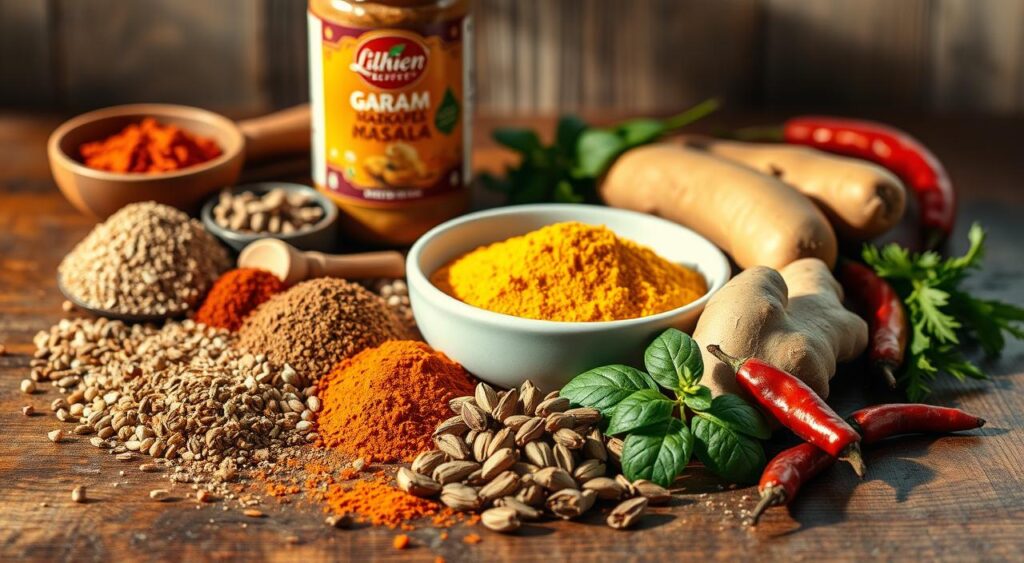
Every chickpea curry needs a core spice mix. Cumin, coriander, and turmeric form the base. Garam masala adds depth, and red chili powder or fresh chilies add heat.
Mustard seeds and curry leaves add unique flavors. A pinch of asafoetida (hing) adds depth that’s hard to get otherwise.
Optional Flavor Enhancers
While core spices are essential, some optional spices can make your curry even better. Cardamom pods, cinnamon sticks, and cloves add warmth and sweetness.
Fenugreek seeds or powder add a slight bitterness. Amchur (dried mango powder) adds tanginess. These spices let you customize your homemade chickpea curry to your liking.
Fresh Ingredients That Elevate the Dish
Fresh ingredients add brightness and texture to your curry. They make each spoonful exciting.
Onions, garlic, and ginger are key. Sauté them until the onions are caramelized. This adds natural sweetness that balances the spices in your flavorful chickpea curry.
Fresh tomatoes add acidity and sweetness. Cook them down to make a thick sauce. This sauce is perfect for your chickpeas to soak up all the flavors.
Finish with fresh herbs like cilantro or mint. These add a refreshing touch. For creaminess, add coconut milk or yogurt. It changes the texture and flavor of your curry.
Kitchen Equipment You’ll Need
Before we start our easy chickpea curry recipe, let’s look at the kitchen tools you’ll need. Making homemade chickpea curry is simple, thanks to basic tools and a good cooking vessel. You won’t need fancy gadgets to make a delicious meal.
Basic Tools for Preparation
Chickpea curry is easy to make, starting with basic tools. A sharp chef’s knife is key for chopping onions, garlic, ginger, and veggies. It makes prep work quick and easy.
A sturdy cutting board is also essential for safe chopping. Keep your measuring spoons and cups nearby for accurate spice and liquid measurements. This is important for a great curry flavor.
For canned chickpeas, a can opener is a must. Use a wooden spoon or heat-resistant spatula for stirring and preventing sticking. A microplane or small grater is useful for grating ginger or garlic for a smooth curry.
Cooking Vessels for Best Results
The right pot or pan is key for a great chickpea curry. Choose a heavy-bottomed pot or deep skillet for even heat and to prevent burning. This is important with spices.
While a karahi is traditional, any wide, deep pan works well for home cooking. Cast iron pans are great for retaining heat and caramelizing, adding flavor to your curry.
For slow-cooked curries, a Dutch oven is perfect for consistent heat. For quicker cooking, try an Instant Pot or pressure cooker with dried chickpeas. Even a wok can be used for quick, even cooking.
Preparation Before Cooking
Before you start cooking, preparing your ingredients is key. It makes your simple chickpea curry recipe easy and enjoyable. With everything ready, cooking becomes a smooth and fun process.
Preparing Dried Chickpeas (If Using)
Dried chickpeas give your curry better texture and taste. Start by checking the chickpeas for stones or damaged beans. This step helps avoid surprises in your meal.
Then, soak the chickpeas in water for 8-12 hours. This is the easiest way to prepare them. If you’re in a hurry, there’s a quick-soak method too.
After soaking, rinse and cook the chickpeas until they’re tender. This step is crucial before adding them to your curry.
| Soaking Method | Time Required | Cooking Time After | Best For |
|---|---|---|---|
| Traditional Soak | 8-12 hours | 45-60 minutes | Planning ahead |
| Quick Hot Soak | 1 hour | 45-60 minutes | Same-day cooking |
| Pressure Cooker | No soaking needed | 15-20 minutes | Last-minute meals |
Chopping and Measuring Ingredients
“Mise en place” is essential for a simple chickpea curry recipe. Start by gathering all ingredients and organizing them. This avoids the stress of missing a spice during cooking.
Chop ingredients evenly for even cooking. Cut onions into ¼ inch pieces for quick cooking. Mince garlic and ginger finely to release their flavors well. Cut vegetables like bell peppers or potatoes to similar sizes for even cooking.
Measure spices into small bowls before cooking. This helps add spices correctly and quickly. If using whole spices, count them out ahead of time.
For canned chickpeas, rinse them well to remove excess sodium and starch. This improves the flavor and texture of your curry. Have liquids measured and ready to add at the right time.
Step-by-Step Easy Chickpea Curry Recipe
Making a delicious Easy Chickpea Curry is easier than you think. Our guide will help you through every step. This dish is ready in about 20 minutes, perfect for busy nights. It’s quick, nutritious, and flavorful, without the long cooking time.
We’ve broken down the cooking into simple stages. This way, even if you’re new to curry, you’ll succeed.
Creating the Aromatic Base
Every curry starts with a flavorful base. Heat 2 tablespoons of oil in a large pot over medium heat. Once it’s hot, add a finely diced medium onion. Cook for 3-4 minutes until it’s translucent and slightly golden.
Then, add 3 cloves of minced garlic and 1 tablespoon of freshly grated ginger. Cook them gently for about a minute. This releases their fragrance. Be careful not to burn them, as it can make the curry bitter.
If you’re using fresh chilies for heat, add them now. For a tomato-based curry, stir in 1 cup of diced tomatoes. Cook until they break down into a thick sauce, about 3-4 minutes. This base will make your curry rich and flavorful.
Adding and Cooking the Spices
The magic of curry is in the spices. Make a small clearing in the pan by pushing the onion mixture to the sides. Add your dry spices to this space:
- 1 teaspoon ground cumin
- 1 teaspoon ground coriander
- 1 teaspoon turmeric
- ½ teaspoon garam masala
Let these spices toast in the hot oil for about 30 seconds. This releases essential oils and intensifies flavors. Quickly stir the spices into your onion mixture to prevent burning.
If using whole spices like cumin or mustard seeds, add them first. Let them pop in the hot oil before adding ground spices. For heat, add ¼ to ½ teaspoon of red chili powder.
Incorporating Chickpeas and Liquid
Now, add the star ingredient. Add 2 cans (about 3 cups) of drained and rinsed chickpeas to the pot. Stir gently to coat them with the spice mixture. If using dried chickpeas, add about 3 cups of pre-cooked ones.
Pour in 1 cup of vegetable broth or water. Use it to deglaze the pan by scraping up flavorful bits. For creaminess, add 1 cup of coconut milk or tomato puree.
If you’re adding vegetables like spinach, bell peppers, or potatoes, add them now. Cut them to sizes that will cook in similar time. Stir everything together, making sure all ingredients are well-coated with the spiced liquid.
Simmering to Perfection
The final stage brings all flavors together beautifully. Bring your mixture to a gentle boil, then reduce heat to low and cover the pot. Let it simmer for 15-20 minutes, stirring occasionally to prevent sticking.
This simmering time does several things. It lets chickpeas absorb spice flavors, thickens the sauce, and cooks vegetables through. If it’s too thick, add a bit more broth. If it’s too thin, simmer uncovered for a few extra minutes.
In the final 5 minutes, taste and adjust seasonings. You might need to add salt, a squeeze of lemon juice, or more garam masala. Just before serving, stir in 2 tablespoons of chopped fresh cilantro. This adds freshness that complements the rich flavors of your curry.
Variations to Try
Ready to elevate your chickpea curry? Let’s dive into three tasty variations. Chickpea curry is super versatile. Once you know the basic recipe, you can tweak it to fit your taste or what you have in your kitchen.
These twists keep the essence of the dish but add new flavors. Each variation brings a unique spin to our quick and easy chickpea curry recipe. This way, your meals will always be exciting.
Coconut Chickpea Curry
Try coconut chickpea curry for a creamy, sweet twist. Use full-fat coconut milk to make a rich sauce that goes well with chickpeas.
For Thai flavors, add lemongrass, Thai basil, and red curry paste. A squeeze of lime juice and a pinch of brown sugar balance the taste, making it sour and sweet.
This version is great with colorful veggies like bell peppers and carrots. The coconut milk’s sweetness helps cool down the heat, perfect for those who like it milder.
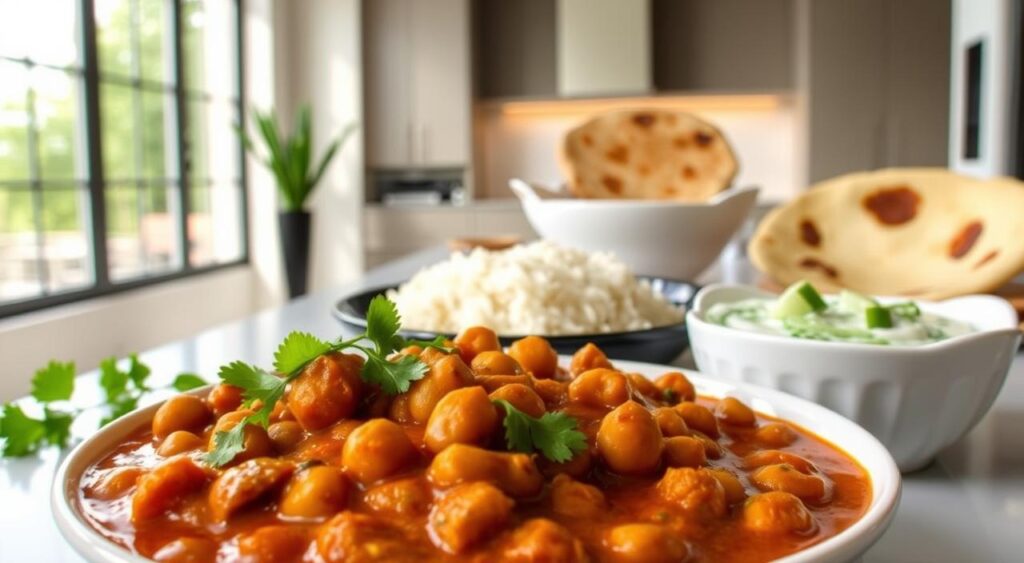
Spinach and Chickpea Curry
Make your curry a nutritional powerhouse with chickpeas and spinach. This mix, inspired by “Palak Chole,” adds color and nutrients.
Start with your curry base, then add 4-6 cups of fresh spinach for the last 3-5 minutes. The spinach wilts into the curry, making a green sauce. For a smoother sauce, blend half the spinach with a bit of water before adding it.
Spinach’s mild bitterness complements curry spices well. A touch of cream or coconut milk balances the flavors and makes the sauce silky.
Spicy Chickpea Curry
For those who love heat, spicy chickpea curry is a bold choice. It’s inspired by vindaloo and other spicy curries.
To make it spicy, use more fresh chilies in your base. Add 1-2 teaspoons of red chili powder or cayenne pepper to your spice mix. Adjust the heat to your liking.
“The true beauty of a spicy chickpea curry lies not just in its heat, but in the complex layers of flavor that develop when the spices bloom in hot oil.”
For more depth, add smoked paprika and black pepper. Tomato paste adds depth and balances the heat with acidity. Serve it with cooling sides like raita or cucumber salad to cool down.
Serving Suggestions
Make your vegetarian chickpea curry a memorable meal with these serving suggestions. The right sides enhance the flavors and turn it into a full dining experience. Choose from classic pairings or modern twists to highlight your healthy chickpea curry.
Traditional Accompaniments
Traditional sides are great because they balance the spices and add texture. They come from South Asian traditions and are loved for their effectiveness.
Start with a bed of rice or fresh bread. They soak up the sauce and let the curry’s flavors shine.
Rice Options
Basmati rice is the gold standard for curry, with its unique aroma and fluffy texture. Brown basmati adds fiber without losing flavor. Jeera rice adds a cumin spice, while saffron rice brings a floral taste and color.
Naan bread is perfect for scooping sauce. Roti or chapati are lighter, whole wheat options. Try flaky paratha for a special touch. South Indian dosas add a tangy twist to spicier curries.
| Accompaniment | Texture | Flavor Profile | Best For |
|---|---|---|---|
| Basmati Rice | Fluffy, separate grains | Aromatic, nutty | Traditional presentation |
| Naan Bread | Soft, slightly chewy | Mild, yeasty | Scooping up sauce |
| Jeera Rice | Fluffy with seeds | Cumin-forward | Added dimension |
| Paratha | Flaky, layered | Buttery, rich | Special occasions |
Modern Pairing Ideas
Modern serving ideas offer fresh takes on your vegetarian chickpea curry. They mix global flavors with the curry’s taste.
Try it over cauliflower rice or zucchini noodles for a light meal. These options add nutrients and let the curry’s flavors shine.
Make a fusion bowl with curry, quinoa, avocado, and microgreens. This adds texture and nutrition, making it a complete meal. For dinner parties, serve in sourdough bread bowls for a wow factor.
For brunch, pair a small curry portion with a poached egg. The yolk adds richness and protein. Add a lemon-dressed salad for balance.
Pro Tips for Chickpea Curry Success
Making flavorful chickpea curry at home is more than just a recipe. It’s about mastering flavor and texture. We’ve gathered expert tips to elevate your curry from good to great. These insights come from years of experience and will fix common issues and boost your dish’s appeal.
Balancing Flavors
The key to a flavorful chickpea curry is balancing five tastes: sweet, sour, salty, bitter, and umami. If your curry tastes flat, it might need a flavor boost in one or more areas.
To add sweetness, use a bit of honey, coconut milk, or sugar. For a lighter taste, squeeze in some fresh lemon or lime juice at the end.
Salt is essential but should be added slowly. For depth, add umami-rich ingredients like tomato paste or soy sauce.
Flavors get better as the curry sits. For the best taste, layer your spices. Start with some, add more during cooking, and finish with garam masala.
Achieving the Perfect Texture
The texture of your homemade chickpea curry is just as important as its flavor. The perfect texture depends on your taste, but some tips apply to everyone.
Chickpeas should be tender but still firm. If using canned, add them late to avoid mushiness.
The sauce should coat the spoon but not be too thick or thin. If it’s too runny, simmer uncovered. If too thick, add broth slowly.
For a silky sauce, puree some chickpeas before adding them. This adds richness while keeping some whole for texture.
The right pot is key—it distributes heat evenly. Let your curry rest for 5-10 minutes before serving. This allows flavors to blend and textures to settle.
Storing and Reheating Your Curry
Storing and reheating your healthy chickpea curry right can make it last for days. Many people find that the flavors get better after a day in the fridge. This is because the spices have more time to blend together.
Refrigeration Guidelines
To store your quick chickpea curry safely, let it cool down first. But don’t leave it out for more than two hours. Put it in airtight glass containers to keep flavors and colors from mixing.
Stored properly, your curry stays good for 3-4 days. When reheating, add a bit of water or broth to keep the chickpeas moist.
For the best taste, warm the curry in a saucepan over low heat. Stir often to avoid burning. If you’re short on time, microwave in 30-second bursts, stirring each time. A sprinkle of cilantro or a squeeze of lemon can make it taste fresh again.
Freezing for Later Use
Our healthy chickpea curry freezes well, making it great for meal prep. Cool it down before putting it in freezer-safe containers or bags. If using bags, lay them flat to save space and thaw faster.
Make sure to leave some room for expansion. Label each container with the date. Frozen curry stays good for up to 3 months.
Thaw it in the fridge overnight for the best taste. Or thaw it quickly in cold water. Once thawed, heat it to 165°F (74°C) before serving. We often double the recipe and freeze half, changing the veggies when reheating.
Conclusion
We’ve shared our love for easy chickpea curry in this guide. It’s a dish that deserves a place in your meals. It’s made with simple ingredients to create something truly special.
The beauty of vegetarian chickpea curry is its flexibility. You can change the spice level, swap vegetables, or adjust the consistency. Each time, it can evolve to match your taste.
This dish is great for busy weeknights and impresses dinner guests. The protein-packed chickpeas and aromatic spices make a satisfying meal. Even meat-eaters love it.
Don’t be afraid to make this easy chickpea curry your own. You might add coconut milk for creaminess or spinach for extra nutrients. The possibilities are endless!
Remember, curry tastes even better the next day. It’s perfect for meal prep. A big batch can feed you all week long.
We hope you’ll start cooking with your spices and a can of chickpeas. Your kitchen will fill with amazing aromas. Your taste buds will thank you for these flavors.
FAQ
Can I use dried chickpeas instead of canned for this curry?
Yes, you can! Dried chickpeas give better texture and taste. Soak them overnight, then cook until tender. This takes 45-60 minutes or 15 minutes in a pressure cooker.
They hold their shape better and soak up more flavors.
How spicy is this chickpea curry recipe?
Our recipe is mild to medium spicy. You can adjust the heat to your liking. For less spice, use less chili powder or cayenne. For more, add more or fresh chilies.
Remember, you can always add more spice, but it’s harder to take it away.
What can I serve with chickpea curry besides rice?
There are many options besides rice. Try naan, roti, or paratha breads. For a low-carb choice, use cauliflower rice or zucchini.
Quinoa or ancient grains are also great. A simple salad with lemon dressing complements it well. Roasted vegetables with spices make a complete meal.
How can I make my chickpea curry creamier?
To make it creamier, add coconut milk or cream near the end of cooking. For a dairy-free option, use cashew cream.
Puree some chickpeas to thicken the sauce. A dollop of yogurt adds creaminess and tanginess.
Is chickpea curry healthy?
Yes, it’s very healthy! Chickpeas are high in protein and fiber. The spices, especially turmeric, have anti-inflammatory effects.
It’s gluten-free and can be vegan. It’s a balanced meal with protein, carbs, and fats.
How long does chickpea curry last in the refrigerator?
It lasts 3-4 days in the fridge. The flavor gets better after a day. Reheat with a splash of water or broth.
Add fresh cilantro for a bright flavor.
Can I freeze quick chickpea curry?
Yes, it freezes well for meal prep. Cool it, then portion into containers or bags. Label and freeze for up to 3 months.
Thaw in the fridge, then reheat gently. Add liquid if needed.
What are the essential spices I need for an authentic-tasting chickpea curry?
You need ground cumin, coriander, turmeric, and garam masala. These four spices are essential. Add mustard seeds, cardamom, cinnamon, and fenugreek for more flavor.
Include chili powder or cayenne for heat. Garlic, ginger, and onions are also key for authentic flavor.
Can I make this vegetarian chickpea curry in an Instant Pot?
Yes, the Instant Pot is great for chickpea curry. Sauté the aromatics and spices first. Use canned chickpeas for 3-4 minutes or dried for 35 minutes.
The Instant Pot saves time and makes the chickpeas tender and flavorful.
What vegetables can I add to my simple chickpea curry?
Chickpea curry is versatile. Try spinach, kale, bell peppers, carrots, cauliflower, peas, potatoes, sweet potatoes, zucchini, and eggplant.
Quick-cooking veggies like spinach and peas go in last. Harder veggies like potatoes go in earlier. Add chopped greens at the end for a nutritional boost.

